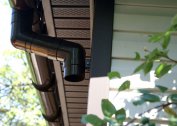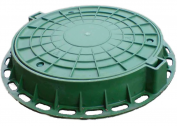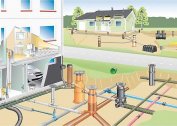Imagine a modern residential building without sewage - this is almost the same as imagine it without a roof or one of the walls. Sewerage has become so firmly entrenched in people's lives that you notice its absence rather than its presence. But although the majority of urban residents are accustomed to centralized sewage systems, where all the waste is collected through pipes into collectors and disposed of by the corresponding utilities, this service is not always available. Often the owner of a separate cottage, cottage or village house has to take care of the sewage system itself. It is for these cases that various autonomous sewage systems have been developed. Let’s try to figure out what types of such systems exist and what are their pros and cons.
Cesspool
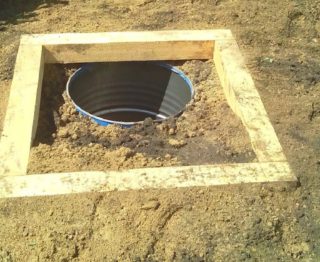 The oldest and easiest way to ensure the disposal of feces. Actually, you can call it a "sewage system" only with a stretch. Even its most modern variants (the so-called powder-closets, where the contents of the pit are occasionally sprinkled with peat or sawdust) can provide the needs of only two to three people. In addition, they can be used comfortably only in the warm season: in winter, the contents of the pit freezes, the biological decomposition of feces does not occur, the pit quickly overflows. The only advantage of this type of toilets is the simplicity and speed of construction: you can dig a hole and knock down a toilet booth yourself in one to two days.
The oldest and easiest way to ensure the disposal of feces. Actually, you can call it a "sewage system" only with a stretch. Even its most modern variants (the so-called powder-closets, where the contents of the pit are occasionally sprinkled with peat or sawdust) can provide the needs of only two to three people. In addition, they can be used comfortably only in the warm season: in winter, the contents of the pit freezes, the biological decomposition of feces does not occur, the pit quickly overflows. The only advantage of this type of toilets is the simplicity and speed of construction: you can dig a hole and knock down a toilet booth yourself in one to two days.
Dry closet
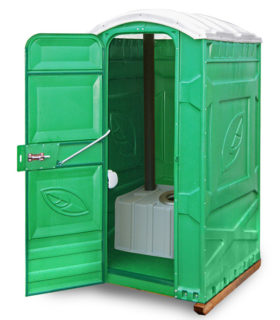 Everyone knows plastic booths that come across in public places or are temporarily placed right on the streets of cities during the holidays. Exactly the same you can get yourself at the cottage. However, by and large, this is also not an option: the dry closet requires care, its owner is forced to regularly clean the tank and purchase special chemicals for processing. In addition, the owner of such a toilet is faced with an eternal problem - where to put on the very stinking liquid that is formed and, frankly, because if you simply drain it on the ground, it will become impossible to live in the house, and the neighbors are unlikely to thank for such a “service”. However, the dry closet may be useful for summer cottages and other houses where people live only temporarily.
Everyone knows plastic booths that come across in public places or are temporarily placed right on the streets of cities during the holidays. Exactly the same you can get yourself at the cottage. However, by and large, this is also not an option: the dry closet requires care, its owner is forced to regularly clean the tank and purchase special chemicals for processing. In addition, the owner of such a toilet is faced with an eternal problem - where to put on the very stinking liquid that is formed and, frankly, because if you simply drain it on the ground, it will become impossible to live in the house, and the neighbors are unlikely to thank for such a “service”. However, the dry closet may be useful for summer cottages and other houses where people live only temporarily.
Septic tank
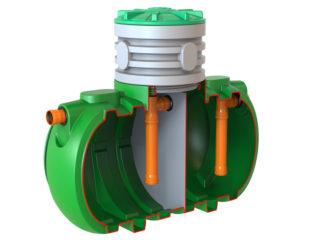 This system can already be called with confidence an autonomous sewer. Its essence is that sewage and fecal water from sinks, bathtubs and toilets installed in the house are directed by gravity pipes to a special tank where bacteria are processed and clarified, after which the treated water goes into the soil through the filter layer. Septic tanks can be either self-made (for a person with minimal construction skills, this is not complicated), or purchased or made to order in construction companies. By their design, septic tanks are divided into single and multi-chamber, depending on the number of chambers in which wastewater is treated. Single chamber are much easier to manufacture, however, do not provide satisfactory filtration and quickly overflow. Therefore, experts advise to manufacture (or order) a septic tank consisting of at least two chambers: the first collects sewage and fecal water, then excess liquid enters the second chamber through the overflow pipe, from which, in fact, it is filtered into the ground or goes into the drainage ditch . The advantage of this solution is that most of the rotting processes occur in the first chamber, and the second is silted up less, and filtering is faster.
This system can already be called with confidence an autonomous sewer. Its essence is that sewage and fecal water from sinks, bathtubs and toilets installed in the house are directed by gravity pipes to a special tank where bacteria are processed and clarified, after which the treated water goes into the soil through the filter layer. Septic tanks can be either self-made (for a person with minimal construction skills, this is not complicated), or purchased or made to order in construction companies. By their design, septic tanks are divided into single and multi-chamber, depending on the number of chambers in which wastewater is treated. Single chamber are much easier to manufacture, however, do not provide satisfactory filtration and quickly overflow. Therefore, experts advise to manufacture (or order) a septic tank consisting of at least two chambers: the first collects sewage and fecal water, then excess liquid enters the second chamber through the overflow pipe, from which, in fact, it is filtered into the ground or goes into the drainage ditch . The advantage of this solution is that most of the rotting processes occur in the first chamber, and the second is silted up less, and filtering is faster.
Autonomous treatment facilities
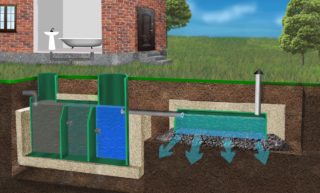 However, despite the simplicity and convenience of conventional septic tanks, they also have a major drawback: they are not always environmentally friendly. Seeping through the ground, the liquid from the septic tanks can reach the aquifer without being completely cleaned. The consequences are obvious: few people want to use stinky feces water for washing or cooking. In addition, one poorly located septic tank can poison the water intake to several houses. That is why now autonomous sewerage systems, which are already mini-treatment facilities, are increasingly being used. They are actively moving wastewater from one tank to another, taking into account the biological characteristics of various types of bacteria. As a result of this, a complete biological treatment takes place, and fecal effluents turn into industrial water (drinking it, of course, is undesirable, but it can already be used for other purposes). However, you have to pay for everything: such systems are not only more expensive than ordinary septic tanks, but also need energy supply to pump fluid from the tank to the tank. An additional advantage is that such systems, as a rule, are adapted so that the owner himself can clean the sludge without causing a sewage machine. The resulting sludge after a year of decay in a compost heap turns into an excellent fertilizer for the garden.
However, despite the simplicity and convenience of conventional septic tanks, they also have a major drawback: they are not always environmentally friendly. Seeping through the ground, the liquid from the septic tanks can reach the aquifer without being completely cleaned. The consequences are obvious: few people want to use stinky feces water for washing or cooking. In addition, one poorly located septic tank can poison the water intake to several houses. That is why now autonomous sewerage systems, which are already mini-treatment facilities, are increasingly being used. They are actively moving wastewater from one tank to another, taking into account the biological characteristics of various types of bacteria. As a result of this, a complete biological treatment takes place, and fecal effluents turn into industrial water (drinking it, of course, is undesirable, but it can already be used for other purposes). However, you have to pay for everything: such systems are not only more expensive than ordinary septic tanks, but also need energy supply to pump fluid from the tank to the tank. An additional advantage is that such systems, as a rule, are adapted so that the owner himself can clean the sludge without causing a sewage machine. The resulting sludge after a year of decay in a compost heap turns into an excellent fertilizer for the garden.
What should be remembered by the owner of an autonomous sewer
Whatever the autonomous sewage system, its owner should clearly know the few rules for its use:
- Do not block sewage. This is especially true for those structures where waste flows into the septic tank or sewage treatment plant by gravity. But even where special pumps for pumping wastewater are provided, you should not confuse the toilet with a garbage container. Remember: everything that has got into the tank and cannot rot will remain there, and a clogged sewage system in the winter can turn into freezing and pipe rupture;
- regularly clean: pumping sludge from the septic tank, removing the contents of the cesspool. An overfilled tank is not only an inconvenience, but also a serious environmental hazard;
- do not use sludge from septic tanks or treatment facilities to feed plants. The fact is that human feces are too biologically active, and plants simply “burn out” from an excess of nitrogen. Use a compost heap: silt requires at least six months to turn into fertilizer. The exception can only be the contents of powder-closet, where rotting occurs with the participation of aerobic bacteria, however, and if possible, rotted feces should be mixed with soil or peat.
